Managing Human Resources: Software Industry Recruitment Challenges
VerifiedAdded on 2020/04/01
|11
|2670
|254
Report
AI Summary
This report delves into the multifaceted challenges of recruitment within the software industry, a sector characterized by rapid growth and intense competition for skilled talent. It highlights key issues such as lengthy recruitment processes, the constant need to source candidates from various channels, the high demand for skilled employees, cost considerations, the challenge of millennial retention, and the impact of strong competition. The report then proposes several HRM-based solutions, including structuring the recruitment process for efficiency, investing in employee training programs to address skill gaps, and fostering a positive organizational culture to attract and retain top talent. The report concludes that effective HRM strategies are crucial for software companies to navigate these challenges, ensuring sustainable growth and success in a dynamic industry.
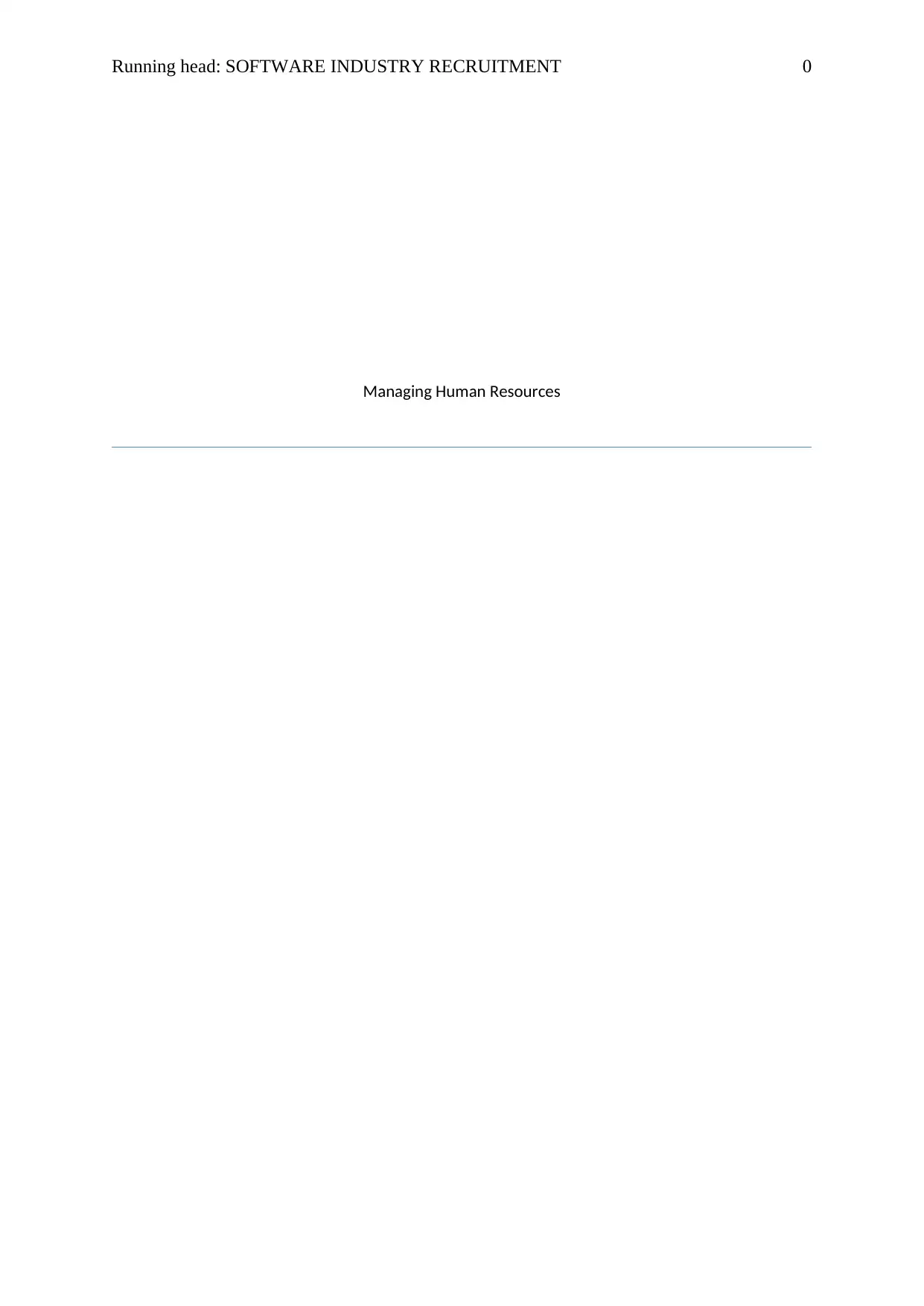
Running head: SOFTWARE INDUSTRY RECRUITMENT 0
Managing Human Resources
Managing Human Resources
Paraphrase This Document
Need a fresh take? Get an instant paraphrase of this document with our AI Paraphraser
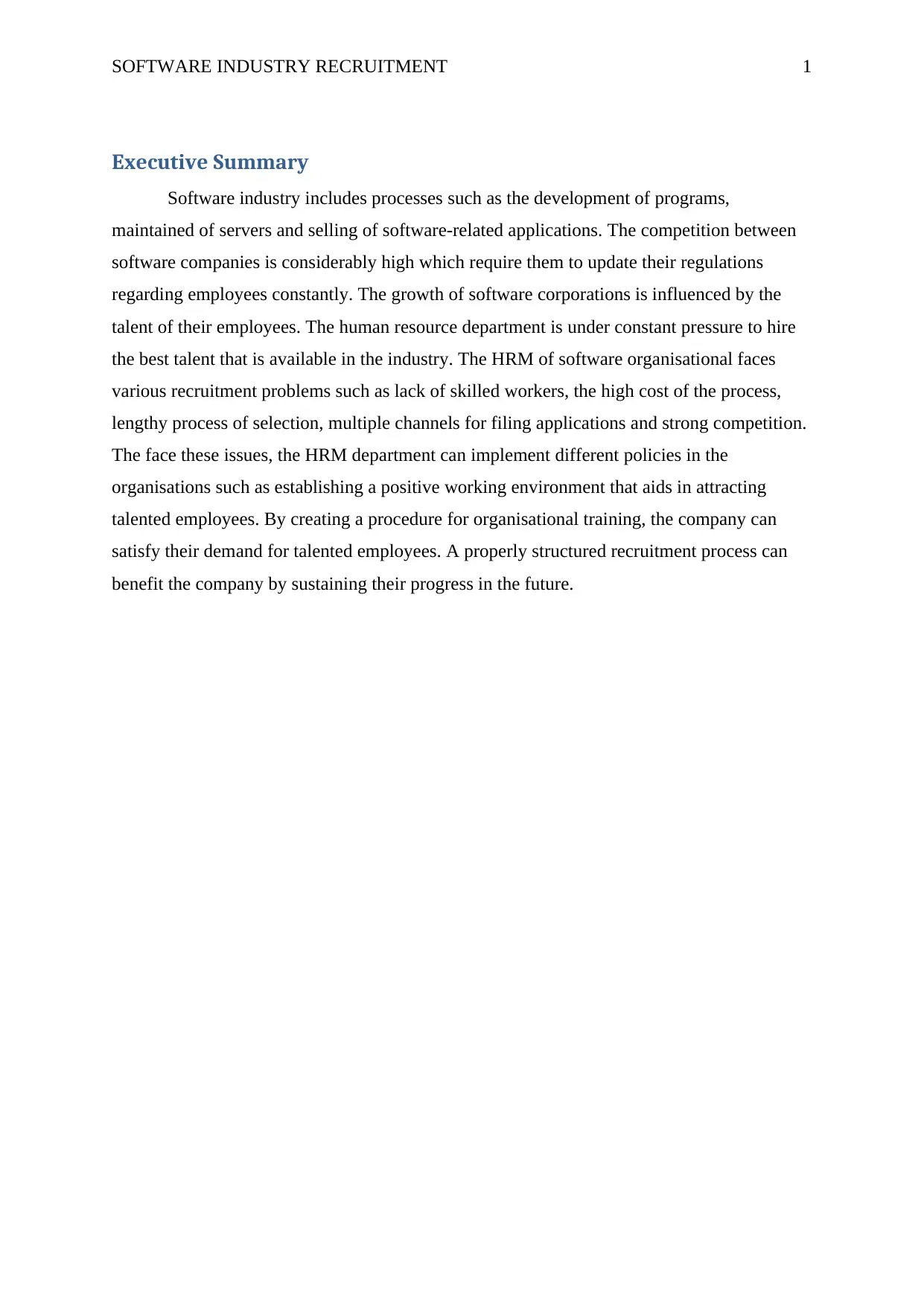
SOFTWARE INDUSTRY RECRUITMENT 1
Executive Summary
Software industry includes processes such as the development of programs,
maintained of servers and selling of software-related applications. The competition between
software companies is considerably high which require them to update their regulations
regarding employees constantly. The growth of software corporations is influenced by the
talent of their employees. The human resource department is under constant pressure to hire
the best talent that is available in the industry. The HRM of software organisational faces
various recruitment problems such as lack of skilled workers, the high cost of the process,
lengthy process of selection, multiple channels for filing applications and strong competition.
The face these issues, the HRM department can implement different policies in the
organisations such as establishing a positive working environment that aids in attracting
talented employees. By creating a procedure for organisational training, the company can
satisfy their demand for talented employees. A properly structured recruitment process can
benefit the company by sustaining their progress in the future.
Executive Summary
Software industry includes processes such as the development of programs,
maintained of servers and selling of software-related applications. The competition between
software companies is considerably high which require them to update their regulations
regarding employees constantly. The growth of software corporations is influenced by the
talent of their employees. The human resource department is under constant pressure to hire
the best talent that is available in the industry. The HRM of software organisational faces
various recruitment problems such as lack of skilled workers, the high cost of the process,
lengthy process of selection, multiple channels for filing applications and strong competition.
The face these issues, the HRM department can implement different policies in the
organisations such as establishing a positive working environment that aids in attracting
talented employees. By creating a procedure for organisational training, the company can
satisfy their demand for talented employees. A properly structured recruitment process can
benefit the company by sustaining their progress in the future.
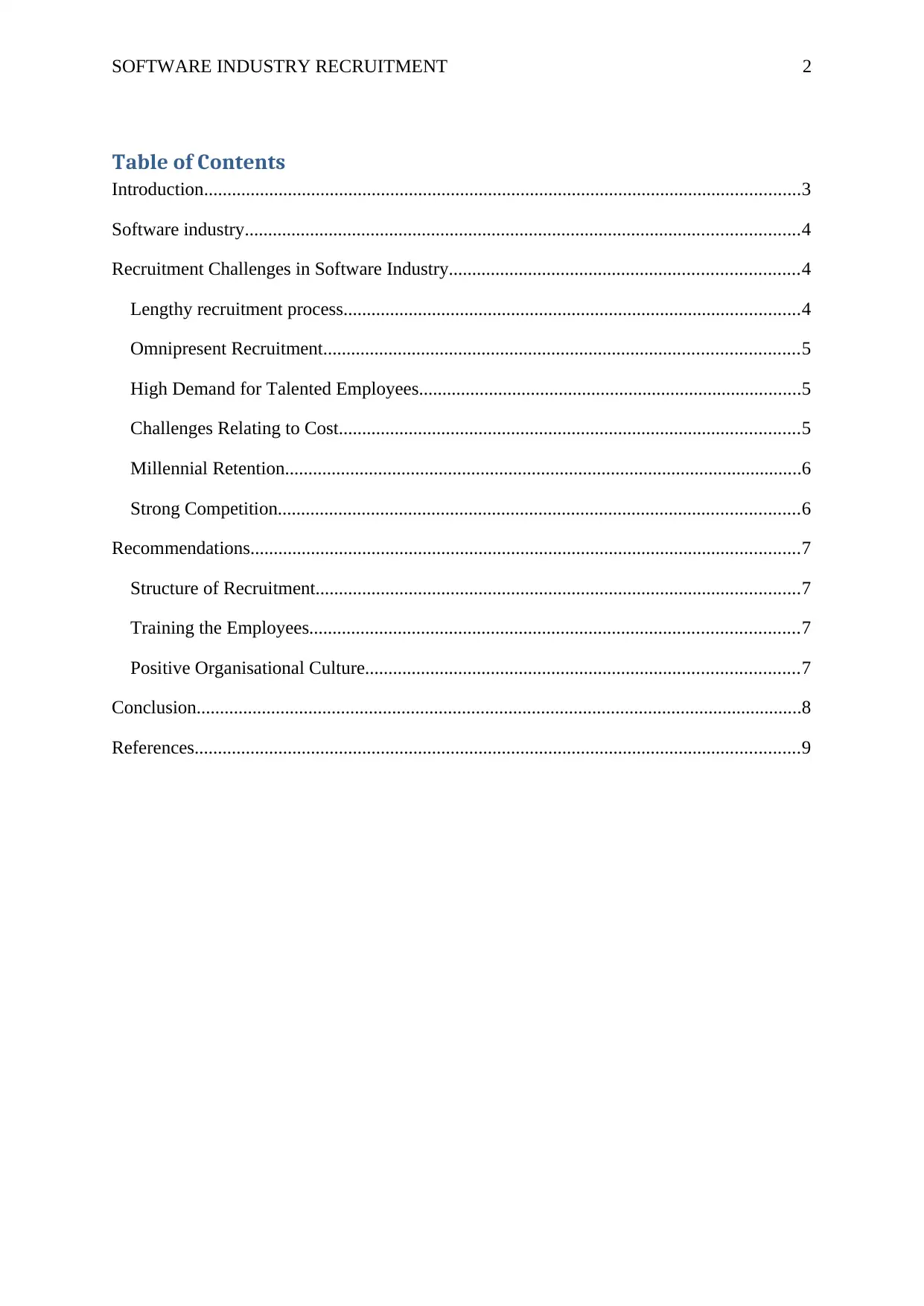
SOFTWARE INDUSTRY RECRUITMENT 2
Table of Contents
Introduction................................................................................................................................3
Software industry.......................................................................................................................4
Recruitment Challenges in Software Industry...........................................................................4
Lengthy recruitment process..................................................................................................4
Omnipresent Recruitment......................................................................................................5
High Demand for Talented Employees..................................................................................5
Challenges Relating to Cost...................................................................................................5
Millennial Retention...............................................................................................................6
Strong Competition................................................................................................................6
Recommendations......................................................................................................................7
Structure of Recruitment........................................................................................................7
Training the Employees.........................................................................................................7
Positive Organisational Culture.............................................................................................7
Conclusion..................................................................................................................................8
References..................................................................................................................................9
Table of Contents
Introduction................................................................................................................................3
Software industry.......................................................................................................................4
Recruitment Challenges in Software Industry...........................................................................4
Lengthy recruitment process..................................................................................................4
Omnipresent Recruitment......................................................................................................5
High Demand for Talented Employees..................................................................................5
Challenges Relating to Cost...................................................................................................5
Millennial Retention...............................................................................................................6
Strong Competition................................................................................................................6
Recommendations......................................................................................................................7
Structure of Recruitment........................................................................................................7
Training the Employees.........................................................................................................7
Positive Organisational Culture.............................................................................................7
Conclusion..................................................................................................................................8
References..................................................................................................................................9
⊘ This is a preview!⊘
Do you want full access?
Subscribe today to unlock all pages.

Trusted by 1+ million students worldwide
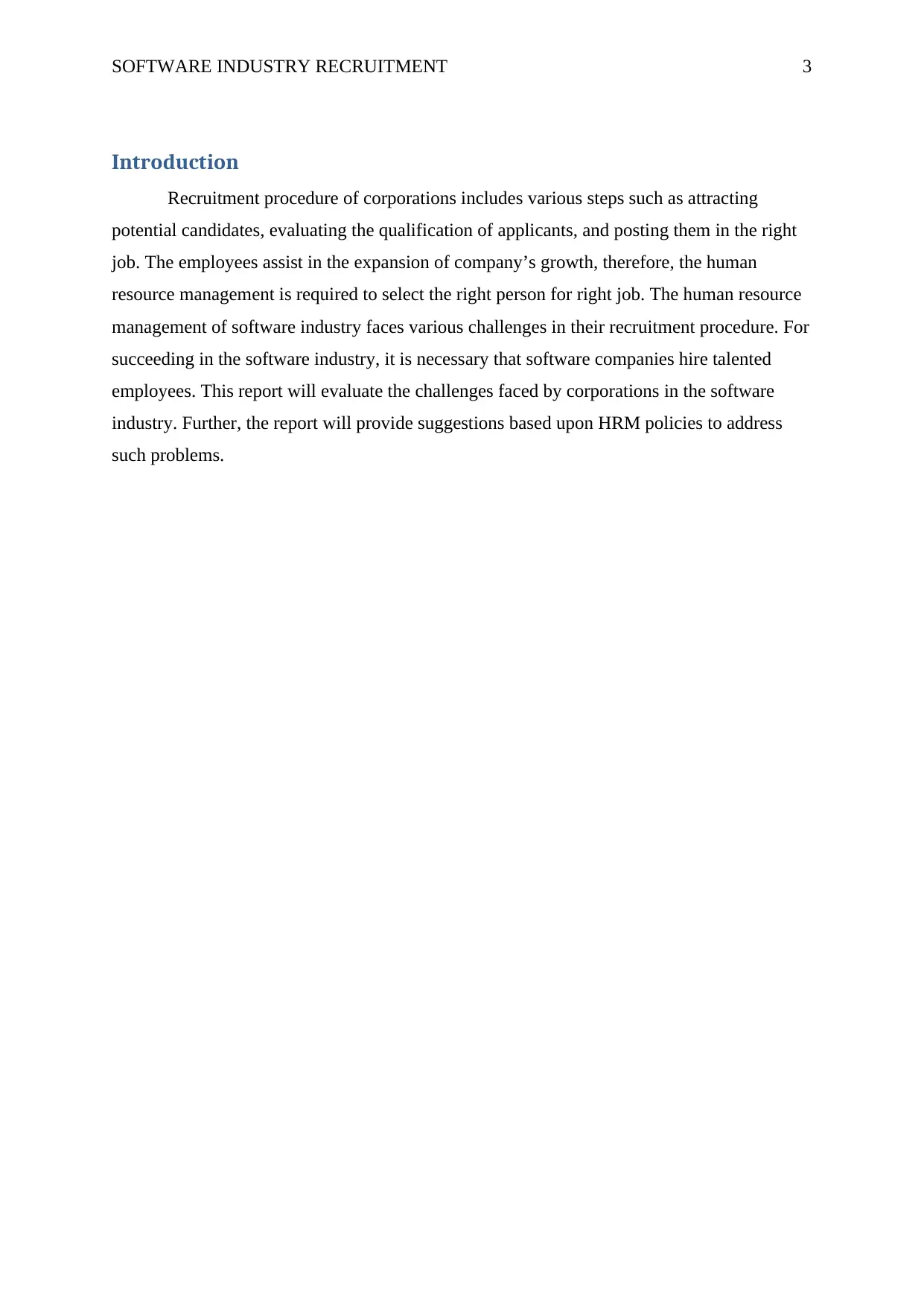
SOFTWARE INDUSTRY RECRUITMENT 3
Introduction
Recruitment procedure of corporations includes various steps such as attracting
potential candidates, evaluating the qualification of applicants, and posting them in the right
job. The employees assist in the expansion of company’s growth, therefore, the human
resource management is required to select the right person for right job. The human resource
management of software industry faces various challenges in their recruitment procedure. For
succeeding in the software industry, it is necessary that software companies hire talented
employees. This report will evaluate the challenges faced by corporations in the software
industry. Further, the report will provide suggestions based upon HRM policies to address
such problems.
Introduction
Recruitment procedure of corporations includes various steps such as attracting
potential candidates, evaluating the qualification of applicants, and posting them in the right
job. The employees assist in the expansion of company’s growth, therefore, the human
resource management is required to select the right person for right job. The human resource
management of software industry faces various challenges in their recruitment procedure. For
succeeding in the software industry, it is necessary that software companies hire talented
employees. This report will evaluate the challenges faced by corporations in the software
industry. Further, the report will provide suggestions based upon HRM policies to address
such problems.
Paraphrase This Document
Need a fresh take? Get an instant paraphrase of this document with our AI Paraphraser
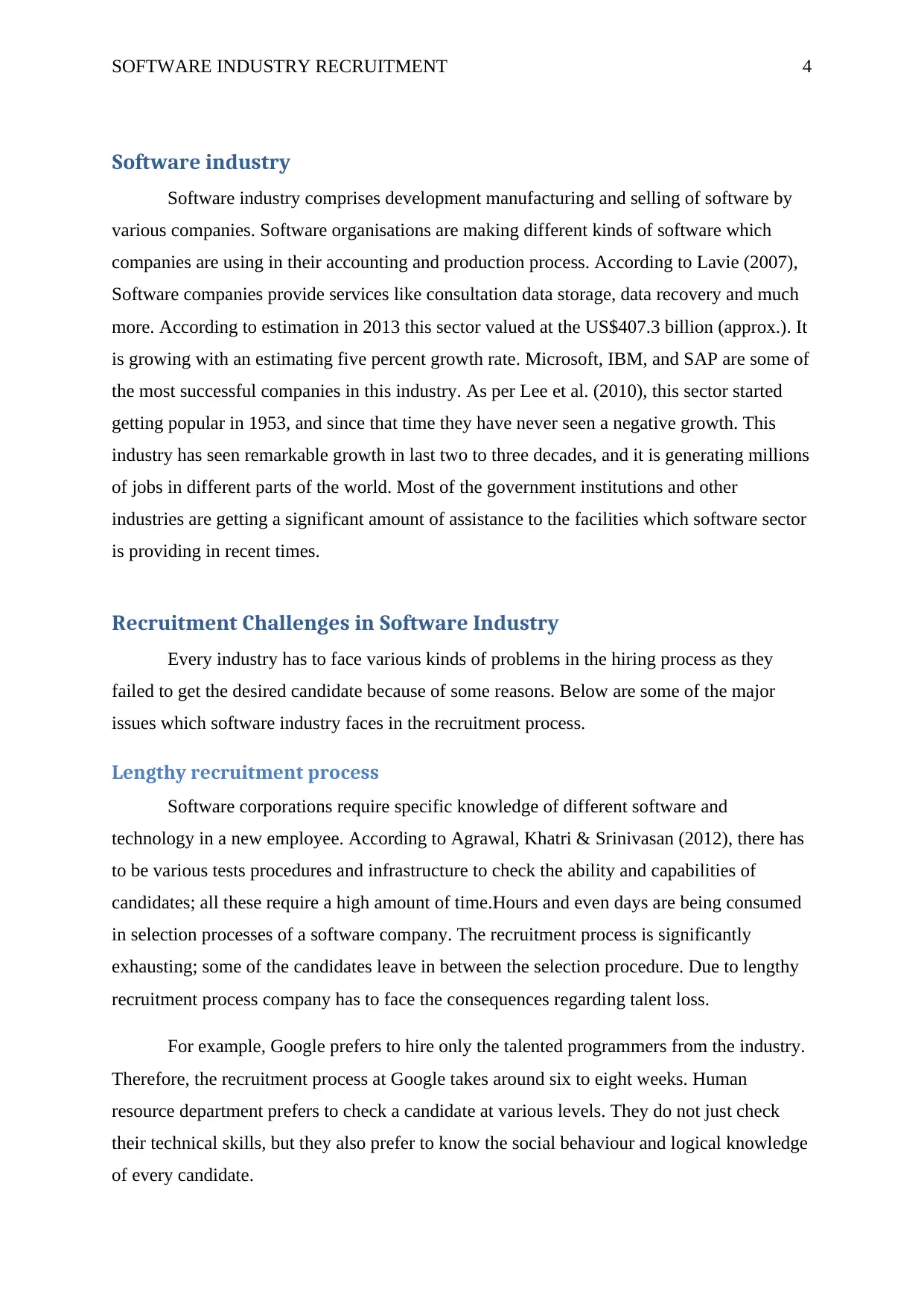
SOFTWARE INDUSTRY RECRUITMENT 4
Software industry
Software industry comprises development manufacturing and selling of software by
various companies. Software organisations are making different kinds of software which
companies are using in their accounting and production process. According to Lavie (2007),
Software companies provide services like consultation data storage, data recovery and much
more. According to estimation in 2013 this sector valued at the US$407.3 billion (approx.). It
is growing with an estimating five percent growth rate. Microsoft, IBM, and SAP are some of
the most successful companies in this industry. As per Lee et al. (2010), this sector started
getting popular in 1953, and since that time they have never seen a negative growth. This
industry has seen remarkable growth in last two to three decades, and it is generating millions
of jobs in different parts of the world. Most of the government institutions and other
industries are getting a significant amount of assistance to the facilities which software sector
is providing in recent times.
Recruitment Challenges in Software Industry
Every industry has to face various kinds of problems in the hiring process as they
failed to get the desired candidate because of some reasons. Below are some of the major
issues which software industry faces in the recruitment process.
Lengthy recruitment process
Software corporations require specific knowledge of different software and
technology in a new employee. According to Agrawal, Khatri & Srinivasan (2012), there has
to be various tests procedures and infrastructure to check the ability and capabilities of
candidates; all these require a high amount of time.Hours and even days are being consumed
in selection processes of a software company. The recruitment process is significantly
exhausting; some of the candidates leave in between the selection procedure. Due to lengthy
recruitment process company has to face the consequences regarding talent loss.
For example, Google prefers to hire only the talented programmers from the industry.
Therefore, the recruitment process at Google takes around six to eight weeks. Human
resource department prefers to check a candidate at various levels. They do not just check
their technical skills, but they also prefer to know the social behaviour and logical knowledge
of every candidate.
Software industry
Software industry comprises development manufacturing and selling of software by
various companies. Software organisations are making different kinds of software which
companies are using in their accounting and production process. According to Lavie (2007),
Software companies provide services like consultation data storage, data recovery and much
more. According to estimation in 2013 this sector valued at the US$407.3 billion (approx.). It
is growing with an estimating five percent growth rate. Microsoft, IBM, and SAP are some of
the most successful companies in this industry. As per Lee et al. (2010), this sector started
getting popular in 1953, and since that time they have never seen a negative growth. This
industry has seen remarkable growth in last two to three decades, and it is generating millions
of jobs in different parts of the world. Most of the government institutions and other
industries are getting a significant amount of assistance to the facilities which software sector
is providing in recent times.
Recruitment Challenges in Software Industry
Every industry has to face various kinds of problems in the hiring process as they
failed to get the desired candidate because of some reasons. Below are some of the major
issues which software industry faces in the recruitment process.
Lengthy recruitment process
Software corporations require specific knowledge of different software and
technology in a new employee. According to Agrawal, Khatri & Srinivasan (2012), there has
to be various tests procedures and infrastructure to check the ability and capabilities of
candidates; all these require a high amount of time.Hours and even days are being consumed
in selection processes of a software company. The recruitment process is significantly
exhausting; some of the candidates leave in between the selection procedure. Due to lengthy
recruitment process company has to face the consequences regarding talent loss.
For example, Google prefers to hire only the talented programmers from the industry.
Therefore, the recruitment process at Google takes around six to eight weeks. Human
resource department prefers to check a candidate at various levels. They do not just check
their technical skills, but they also prefer to know the social behaviour and logical knowledge
of every candidate.
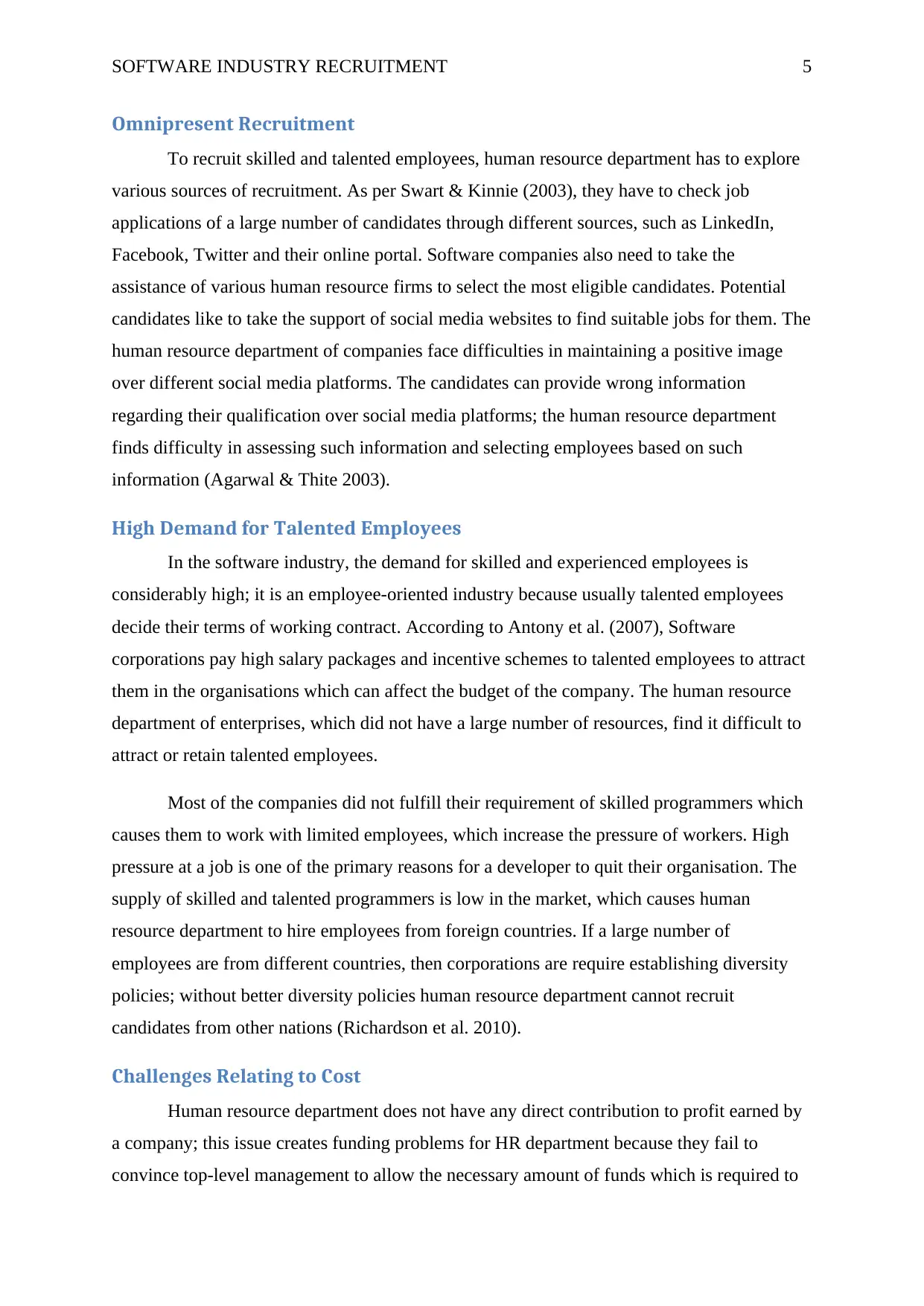
SOFTWARE INDUSTRY RECRUITMENT 5
Omnipresent Recruitment
To recruit skilled and talented employees, human resource department has to explore
various sources of recruitment. As per Swart & Kinnie (2003), they have to check job
applications of a large number of candidates through different sources, such as LinkedIn,
Facebook, Twitter and their online portal. Software companies also need to take the
assistance of various human resource firms to select the most eligible candidates. Potential
candidates like to take the support of social media websites to find suitable jobs for them. The
human resource department of companies face difficulties in maintaining a positive image
over different social media platforms. The candidates can provide wrong information
regarding their qualification over social media platforms; the human resource department
finds difficulty in assessing such information and selecting employees based on such
information (Agarwal & Thite 2003).
High Demand for Talented Employees
In the software industry, the demand for skilled and experienced employees is
considerably high; it is an employee-oriented industry because usually talented employees
decide their terms of working contract. According to Antony et al. (2007), Software
corporations pay high salary packages and incentive schemes to talented employees to attract
them in the organisations which can affect the budget of the company. The human resource
department of enterprises, which did not have a large number of resources, find it difficult to
attract or retain talented employees.
Most of the companies did not fulfill their requirement of skilled programmers which
causes them to work with limited employees, which increase the pressure of workers. High
pressure at a job is one of the primary reasons for a developer to quit their organisation. The
supply of skilled and talented programmers is low in the market, which causes human
resource department to hire employees from foreign countries. If a large number of
employees are from different countries, then corporations are require establishing diversity
policies; without better diversity policies human resource department cannot recruit
candidates from other nations (Richardson et al. 2010).
Challenges Relating to Cost
Human resource department does not have any direct contribution to profit earned by
a company; this issue creates funding problems for HR department because they fail to
convince top-level management to allow the necessary amount of funds which is required to
Omnipresent Recruitment
To recruit skilled and talented employees, human resource department has to explore
various sources of recruitment. As per Swart & Kinnie (2003), they have to check job
applications of a large number of candidates through different sources, such as LinkedIn,
Facebook, Twitter and their online portal. Software companies also need to take the
assistance of various human resource firms to select the most eligible candidates. Potential
candidates like to take the support of social media websites to find suitable jobs for them. The
human resource department of companies face difficulties in maintaining a positive image
over different social media platforms. The candidates can provide wrong information
regarding their qualification over social media platforms; the human resource department
finds difficulty in assessing such information and selecting employees based on such
information (Agarwal & Thite 2003).
High Demand for Talented Employees
In the software industry, the demand for skilled and experienced employees is
considerably high; it is an employee-oriented industry because usually talented employees
decide their terms of working contract. According to Antony et al. (2007), Software
corporations pay high salary packages and incentive schemes to talented employees to attract
them in the organisations which can affect the budget of the company. The human resource
department of enterprises, which did not have a large number of resources, find it difficult to
attract or retain talented employees.
Most of the companies did not fulfill their requirement of skilled programmers which
causes them to work with limited employees, which increase the pressure of workers. High
pressure at a job is one of the primary reasons for a developer to quit their organisation. The
supply of skilled and talented programmers is low in the market, which causes human
resource department to hire employees from foreign countries. If a large number of
employees are from different countries, then corporations are require establishing diversity
policies; without better diversity policies human resource department cannot recruit
candidates from other nations (Richardson et al. 2010).
Challenges Relating to Cost
Human resource department does not have any direct contribution to profit earned by
a company; this issue creates funding problems for HR department because they fail to
convince top-level management to allow the necessary amount of funds which is required to
⊘ This is a preview!⊘
Do you want full access?
Subscribe today to unlock all pages.

Trusted by 1+ million students worldwide
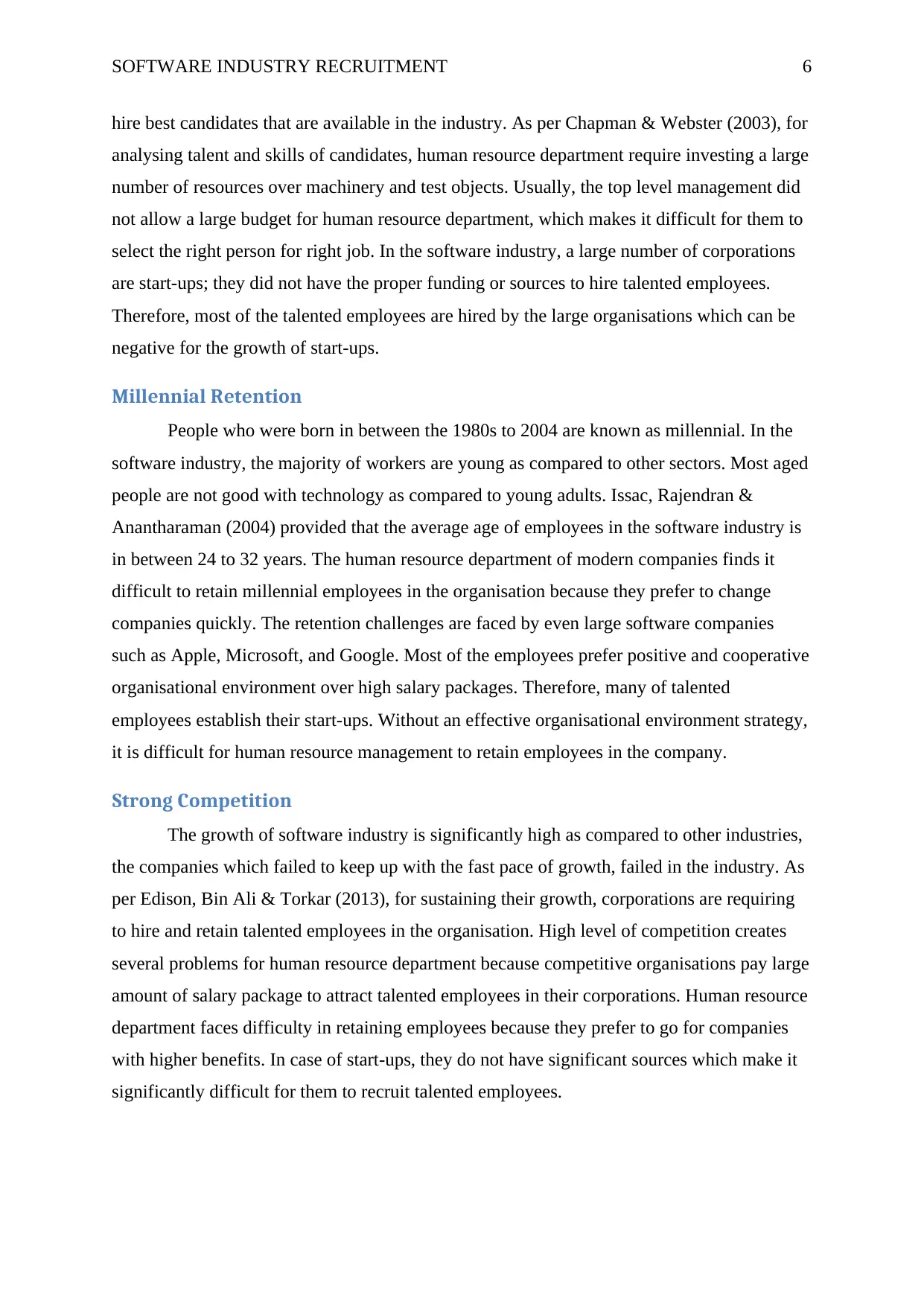
SOFTWARE INDUSTRY RECRUITMENT 6
hire best candidates that are available in the industry. As per Chapman & Webster (2003), for
analysing talent and skills of candidates, human resource department require investing a large
number of resources over machinery and test objects. Usually, the top level management did
not allow a large budget for human resource department, which makes it difficult for them to
select the right person for right job. In the software industry, a large number of corporations
are start-ups; they did not have the proper funding or sources to hire talented employees.
Therefore, most of the talented employees are hired by the large organisations which can be
negative for the growth of start-ups.
Millennial Retention
People who were born in between the 1980s to 2004 are known as millennial. In the
software industry, the majority of workers are young as compared to other sectors. Most aged
people are not good with technology as compared to young adults. Issac, Rajendran &
Anantharaman (2004) provided that the average age of employees in the software industry is
in between 24 to 32 years. The human resource department of modern companies finds it
difficult to retain millennial employees in the organisation because they prefer to change
companies quickly. The retention challenges are faced by even large software companies
such as Apple, Microsoft, and Google. Most of the employees prefer positive and cooperative
organisational environment over high salary packages. Therefore, many of talented
employees establish their start-ups. Without an effective organisational environment strategy,
it is difficult for human resource management to retain employees in the company.
Strong Competition
The growth of software industry is significantly high as compared to other industries,
the companies which failed to keep up with the fast pace of growth, failed in the industry. As
per Edison, Bin Ali & Torkar (2013), for sustaining their growth, corporations are requiring
to hire and retain talented employees in the organisation. High level of competition creates
several problems for human resource department because competitive organisations pay large
amount of salary package to attract talented employees in their corporations. Human resource
department faces difficulty in retaining employees because they prefer to go for companies
with higher benefits. In case of start-ups, they do not have significant sources which make it
significantly difficult for them to recruit talented employees.
hire best candidates that are available in the industry. As per Chapman & Webster (2003), for
analysing talent and skills of candidates, human resource department require investing a large
number of resources over machinery and test objects. Usually, the top level management did
not allow a large budget for human resource department, which makes it difficult for them to
select the right person for right job. In the software industry, a large number of corporations
are start-ups; they did not have the proper funding or sources to hire talented employees.
Therefore, most of the talented employees are hired by the large organisations which can be
negative for the growth of start-ups.
Millennial Retention
People who were born in between the 1980s to 2004 are known as millennial. In the
software industry, the majority of workers are young as compared to other sectors. Most aged
people are not good with technology as compared to young adults. Issac, Rajendran &
Anantharaman (2004) provided that the average age of employees in the software industry is
in between 24 to 32 years. The human resource department of modern companies finds it
difficult to retain millennial employees in the organisation because they prefer to change
companies quickly. The retention challenges are faced by even large software companies
such as Apple, Microsoft, and Google. Most of the employees prefer positive and cooperative
organisational environment over high salary packages. Therefore, many of talented
employees establish their start-ups. Without an effective organisational environment strategy,
it is difficult for human resource management to retain employees in the company.
Strong Competition
The growth of software industry is significantly high as compared to other industries,
the companies which failed to keep up with the fast pace of growth, failed in the industry. As
per Edison, Bin Ali & Torkar (2013), for sustaining their growth, corporations are requiring
to hire and retain talented employees in the organisation. High level of competition creates
several problems for human resource department because competitive organisations pay large
amount of salary package to attract talented employees in their corporations. Human resource
department faces difficulty in retaining employees because they prefer to go for companies
with higher benefits. In case of start-ups, they do not have significant sources which make it
significantly difficult for them to recruit talented employees.
Paraphrase This Document
Need a fresh take? Get an instant paraphrase of this document with our AI Paraphraser
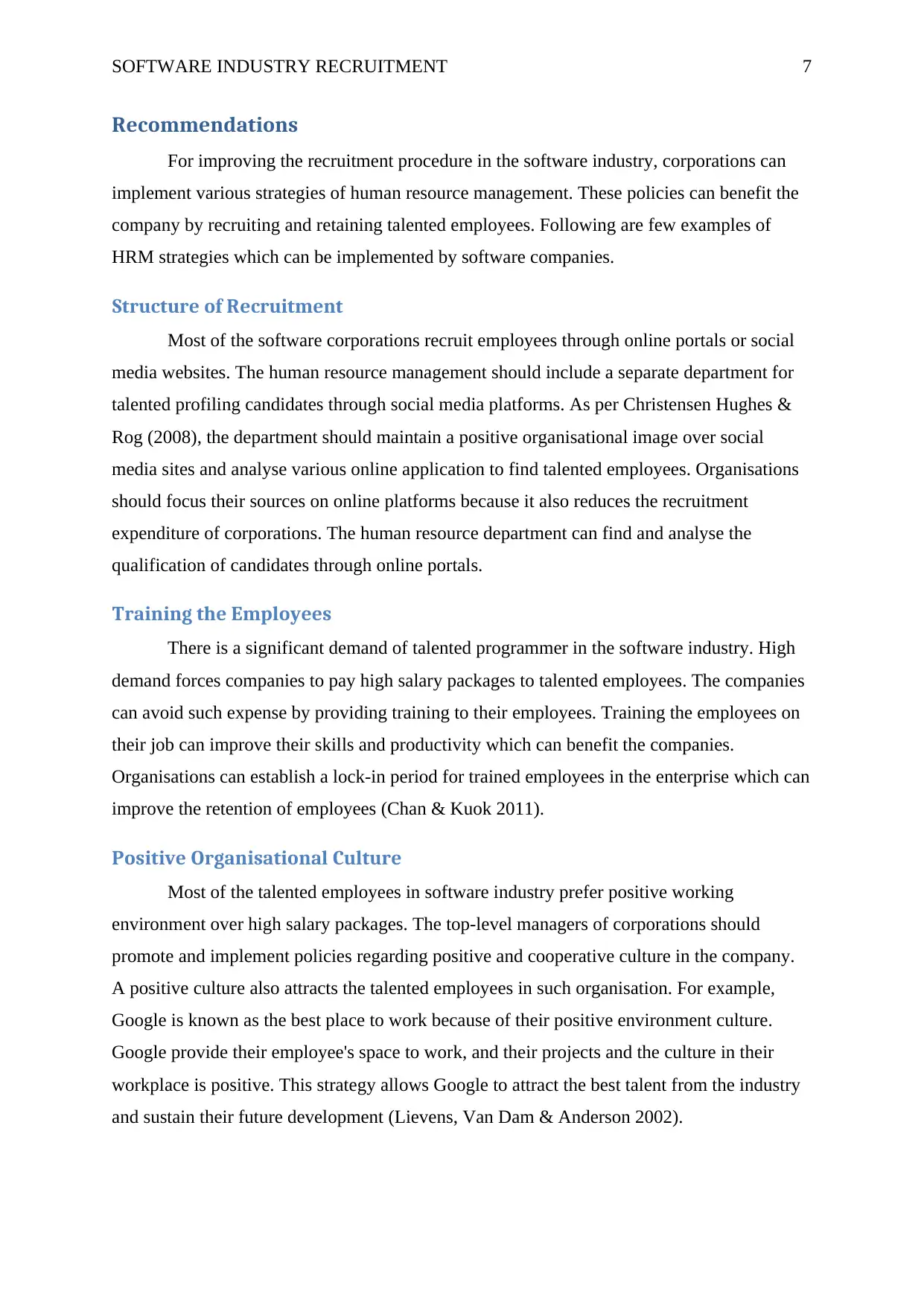
SOFTWARE INDUSTRY RECRUITMENT 7
Recommendations
For improving the recruitment procedure in the software industry, corporations can
implement various strategies of human resource management. These policies can benefit the
company by recruiting and retaining talented employees. Following are few examples of
HRM strategies which can be implemented by software companies.
Structure of Recruitment
Most of the software corporations recruit employees through online portals or social
media websites. The human resource management should include a separate department for
talented profiling candidates through social media platforms. As per Christensen Hughes &
Rog (2008), the department should maintain a positive organisational image over social
media sites and analyse various online application to find talented employees. Organisations
should focus their sources on online platforms because it also reduces the recruitment
expenditure of corporations. The human resource department can find and analyse the
qualification of candidates through online portals.
Training the Employees
There is a significant demand of talented programmer in the software industry. High
demand forces companies to pay high salary packages to talented employees. The companies
can avoid such expense by providing training to their employees. Training the employees on
their job can improve their skills and productivity which can benefit the companies.
Organisations can establish a lock-in period for trained employees in the enterprise which can
improve the retention of employees (Chan & Kuok 2011).
Positive Organisational Culture
Most of the talented employees in software industry prefer positive working
environment over high salary packages. The top-level managers of corporations should
promote and implement policies regarding positive and cooperative culture in the company.
A positive culture also attracts the talented employees in such organisation. For example,
Google is known as the best place to work because of their positive environment culture.
Google provide their employee's space to work, and their projects and the culture in their
workplace is positive. This strategy allows Google to attract the best talent from the industry
and sustain their future development (Lievens, Van Dam & Anderson 2002).
Recommendations
For improving the recruitment procedure in the software industry, corporations can
implement various strategies of human resource management. These policies can benefit the
company by recruiting and retaining talented employees. Following are few examples of
HRM strategies which can be implemented by software companies.
Structure of Recruitment
Most of the software corporations recruit employees through online portals or social
media websites. The human resource management should include a separate department for
talented profiling candidates through social media platforms. As per Christensen Hughes &
Rog (2008), the department should maintain a positive organisational image over social
media sites and analyse various online application to find talented employees. Organisations
should focus their sources on online platforms because it also reduces the recruitment
expenditure of corporations. The human resource department can find and analyse the
qualification of candidates through online portals.
Training the Employees
There is a significant demand of talented programmer in the software industry. High
demand forces companies to pay high salary packages to talented employees. The companies
can avoid such expense by providing training to their employees. Training the employees on
their job can improve their skills and productivity which can benefit the companies.
Organisations can establish a lock-in period for trained employees in the enterprise which can
improve the retention of employees (Chan & Kuok 2011).
Positive Organisational Culture
Most of the talented employees in software industry prefer positive working
environment over high salary packages. The top-level managers of corporations should
promote and implement policies regarding positive and cooperative culture in the company.
A positive culture also attracts the talented employees in such organisation. For example,
Google is known as the best place to work because of their positive environment culture.
Google provide their employee's space to work, and their projects and the culture in their
workplace is positive. This strategy allows Google to attract the best talent from the industry
and sustain their future development (Lievens, Van Dam & Anderson 2002).
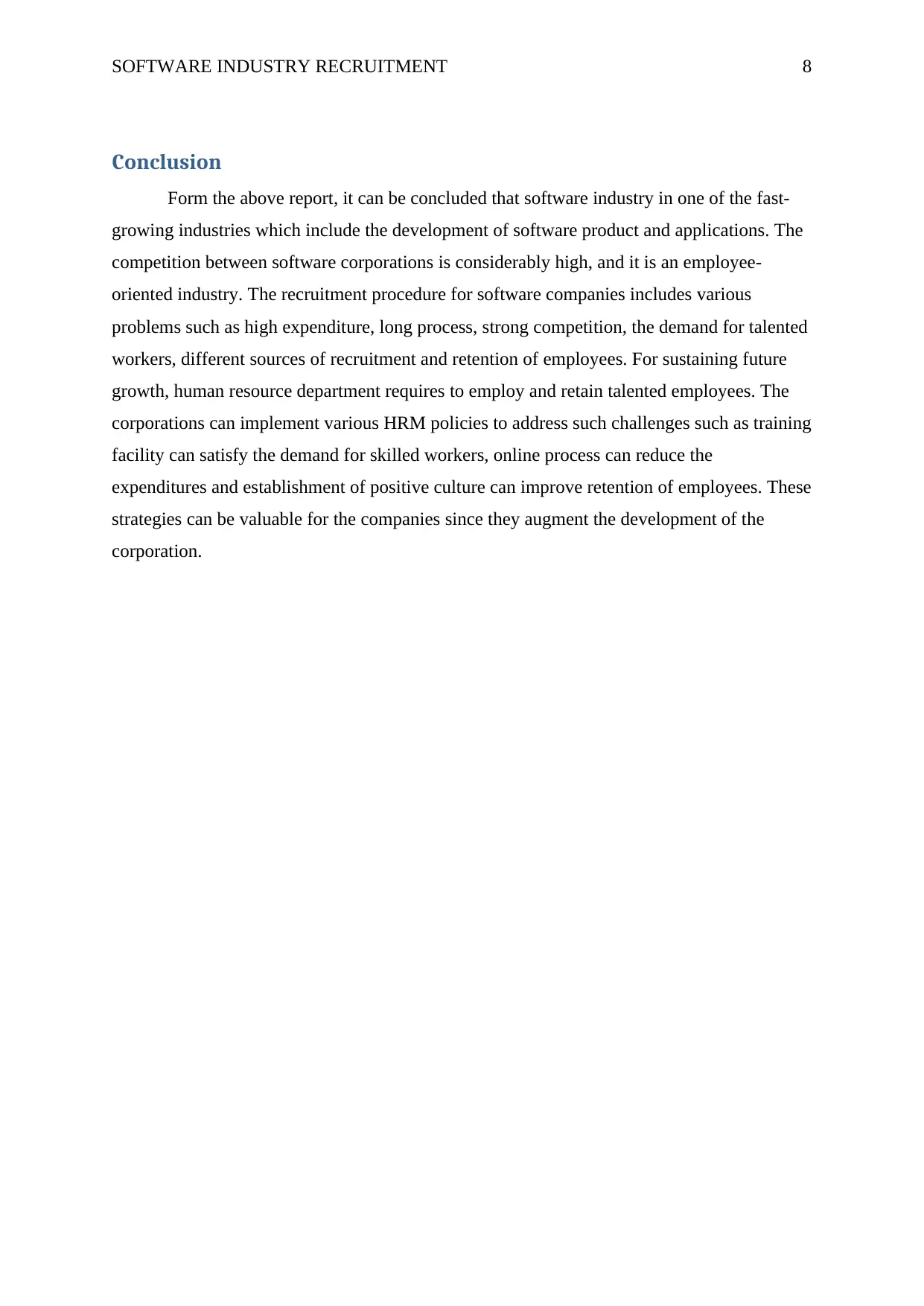
SOFTWARE INDUSTRY RECRUITMENT 8
Conclusion
Form the above report, it can be concluded that software industry in one of the fast-
growing industries which include the development of software product and applications. The
competition between software corporations is considerably high, and it is an employee-
oriented industry. The recruitment procedure for software companies includes various
problems such as high expenditure, long process, strong competition, the demand for talented
workers, different sources of recruitment and retention of employees. For sustaining future
growth, human resource department requires to employ and retain talented employees. The
corporations can implement various HRM policies to address such challenges such as training
facility can satisfy the demand for skilled workers, online process can reduce the
expenditures and establishment of positive culture can improve retention of employees. These
strategies can be valuable for the companies since they augment the development of the
corporation.
Conclusion
Form the above report, it can be concluded that software industry in one of the fast-
growing industries which include the development of software product and applications. The
competition between software corporations is considerably high, and it is an employee-
oriented industry. The recruitment procedure for software companies includes various
problems such as high expenditure, long process, strong competition, the demand for talented
workers, different sources of recruitment and retention of employees. For sustaining future
growth, human resource department requires to employ and retain talented employees. The
corporations can implement various HRM policies to address such challenges such as training
facility can satisfy the demand for skilled workers, online process can reduce the
expenditures and establishment of positive culture can improve retention of employees. These
strategies can be valuable for the companies since they augment the development of the
corporation.
⊘ This is a preview!⊘
Do you want full access?
Subscribe today to unlock all pages.

Trusted by 1+ million students worldwide
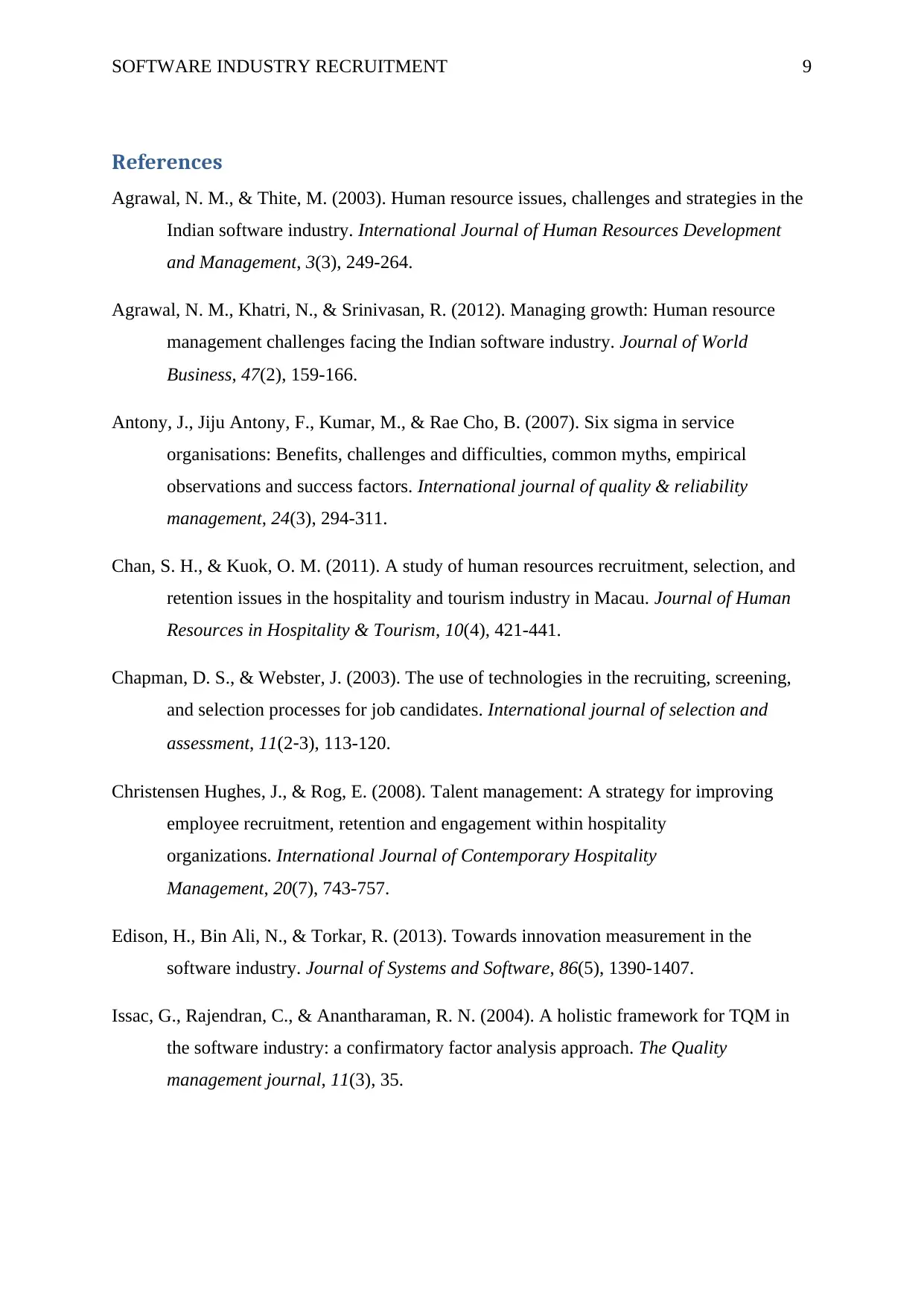
SOFTWARE INDUSTRY RECRUITMENT 9
References
Agrawal, N. M., & Thite, M. (2003). Human resource issues, challenges and strategies in the
Indian software industry. International Journal of Human Resources Development
and Management, 3(3), 249-264.
Agrawal, N. M., Khatri, N., & Srinivasan, R. (2012). Managing growth: Human resource
management challenges facing the Indian software industry. Journal of World
Business, 47(2), 159-166.
Antony, J., Jiju Antony, F., Kumar, M., & Rae Cho, B. (2007). Six sigma in service
organisations: Benefits, challenges and difficulties, common myths, empirical
observations and success factors. International journal of quality & reliability
management, 24(3), 294-311.
Chan, S. H., & Kuok, O. M. (2011). A study of human resources recruitment, selection, and
retention issues in the hospitality and tourism industry in Macau. Journal of Human
Resources in Hospitality & Tourism, 10(4), 421-441.
Chapman, D. S., & Webster, J. (2003). The use of technologies in the recruiting, screening,
and selection processes for job candidates. International journal of selection and
assessment, 11(2‐3), 113-120.
Christensen Hughes, J., & Rog, E. (2008). Talent management: A strategy for improving
employee recruitment, retention and engagement within hospitality
organizations. International Journal of Contemporary Hospitality
Management, 20(7), 743-757.
Edison, H., Bin Ali, N., & Torkar, R. (2013). Towards innovation measurement in the
software industry. Journal of Systems and Software, 86(5), 1390-1407.
Issac, G., Rajendran, C., & Anantharaman, R. N. (2004). A holistic framework for TQM in
the software industry: a confirmatory factor analysis approach. The Quality
management journal, 11(3), 35.
References
Agrawal, N. M., & Thite, M. (2003). Human resource issues, challenges and strategies in the
Indian software industry. International Journal of Human Resources Development
and Management, 3(3), 249-264.
Agrawal, N. M., Khatri, N., & Srinivasan, R. (2012). Managing growth: Human resource
management challenges facing the Indian software industry. Journal of World
Business, 47(2), 159-166.
Antony, J., Jiju Antony, F., Kumar, M., & Rae Cho, B. (2007). Six sigma in service
organisations: Benefits, challenges and difficulties, common myths, empirical
observations and success factors. International journal of quality & reliability
management, 24(3), 294-311.
Chan, S. H., & Kuok, O. M. (2011). A study of human resources recruitment, selection, and
retention issues in the hospitality and tourism industry in Macau. Journal of Human
Resources in Hospitality & Tourism, 10(4), 421-441.
Chapman, D. S., & Webster, J. (2003). The use of technologies in the recruiting, screening,
and selection processes for job candidates. International journal of selection and
assessment, 11(2‐3), 113-120.
Christensen Hughes, J., & Rog, E. (2008). Talent management: A strategy for improving
employee recruitment, retention and engagement within hospitality
organizations. International Journal of Contemporary Hospitality
Management, 20(7), 743-757.
Edison, H., Bin Ali, N., & Torkar, R. (2013). Towards innovation measurement in the
software industry. Journal of Systems and Software, 86(5), 1390-1407.
Issac, G., Rajendran, C., & Anantharaman, R. N. (2004). A holistic framework for TQM in
the software industry: a confirmatory factor analysis approach. The Quality
management journal, 11(3), 35.
Paraphrase This Document
Need a fresh take? Get an instant paraphrase of this document with our AI Paraphraser
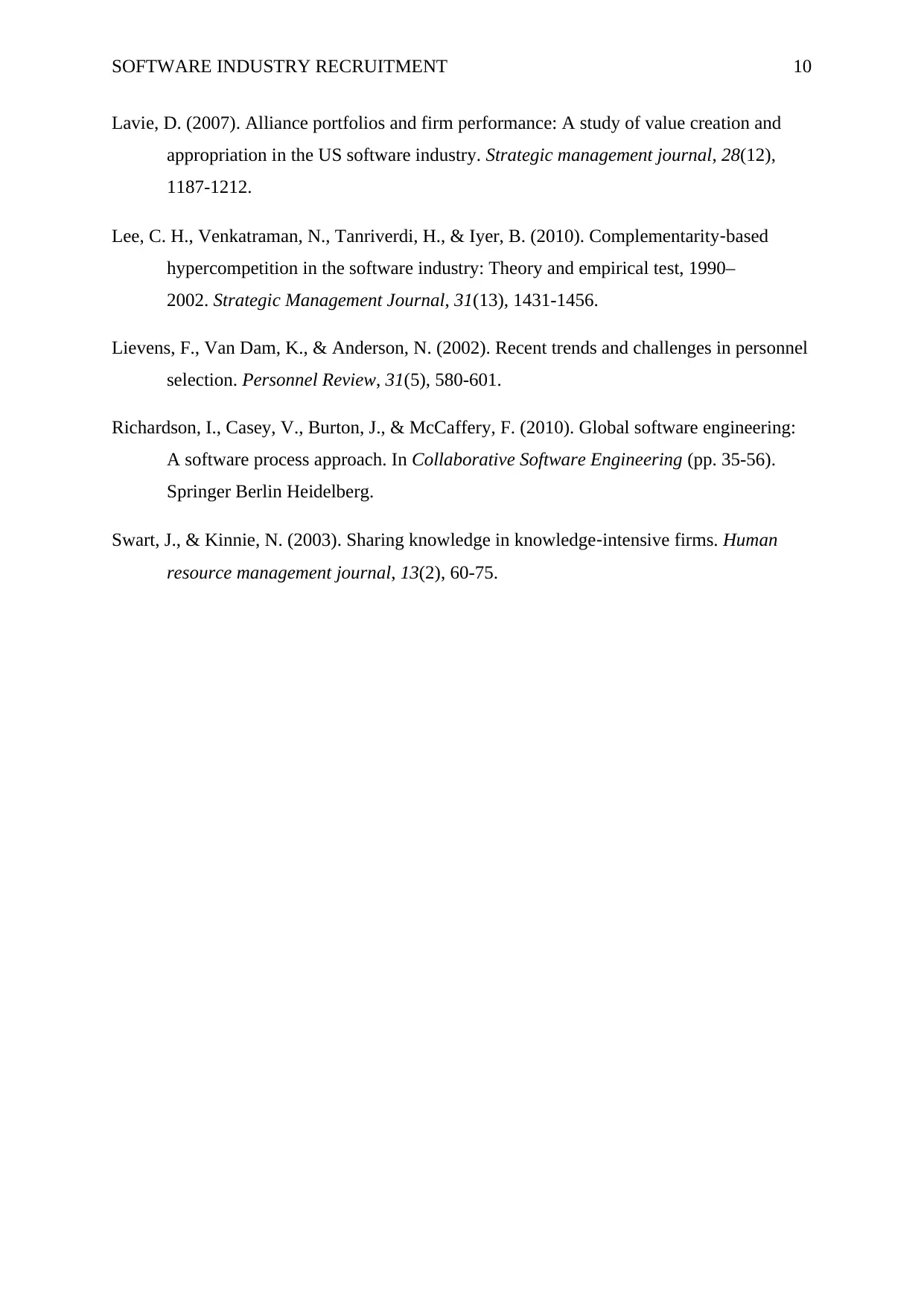
SOFTWARE INDUSTRY RECRUITMENT 10
Lavie, D. (2007). Alliance portfolios and firm performance: A study of value creation and
appropriation in the US software industry. Strategic management journal, 28(12),
1187-1212.
Lee, C. H., Venkatraman, N., Tanriverdi, H., & Iyer, B. (2010). Complementarity‐based
hypercompetition in the software industry: Theory and empirical test, 1990–
2002. Strategic Management Journal, 31(13), 1431-1456.
Lievens, F., Van Dam, K., & Anderson, N. (2002). Recent trends and challenges in personnel
selection. Personnel Review, 31(5), 580-601.
Richardson, I., Casey, V., Burton, J., & McCaffery, F. (2010). Global software engineering:
A software process approach. In Collaborative Software Engineering (pp. 35-56).
Springer Berlin Heidelberg.
Swart, J., & Kinnie, N. (2003). Sharing knowledge in knowledge‐intensive firms. Human
resource management journal, 13(2), 60-75.
Lavie, D. (2007). Alliance portfolios and firm performance: A study of value creation and
appropriation in the US software industry. Strategic management journal, 28(12),
1187-1212.
Lee, C. H., Venkatraman, N., Tanriverdi, H., & Iyer, B. (2010). Complementarity‐based
hypercompetition in the software industry: Theory and empirical test, 1990–
2002. Strategic Management Journal, 31(13), 1431-1456.
Lievens, F., Van Dam, K., & Anderson, N. (2002). Recent trends and challenges in personnel
selection. Personnel Review, 31(5), 580-601.
Richardson, I., Casey, V., Burton, J., & McCaffery, F. (2010). Global software engineering:
A software process approach. In Collaborative Software Engineering (pp. 35-56).
Springer Berlin Heidelberg.
Swart, J., & Kinnie, N. (2003). Sharing knowledge in knowledge‐intensive firms. Human
resource management journal, 13(2), 60-75.
1 out of 11
Related Documents
Your All-in-One AI-Powered Toolkit for Academic Success.
+13062052269
info@desklib.com
Available 24*7 on WhatsApp / Email
![[object Object]](/_next/static/media/star-bottom.7253800d.svg)
Unlock your academic potential
Copyright © 2020–2025 A2Z Services. All Rights Reserved. Developed and managed by ZUCOL.





